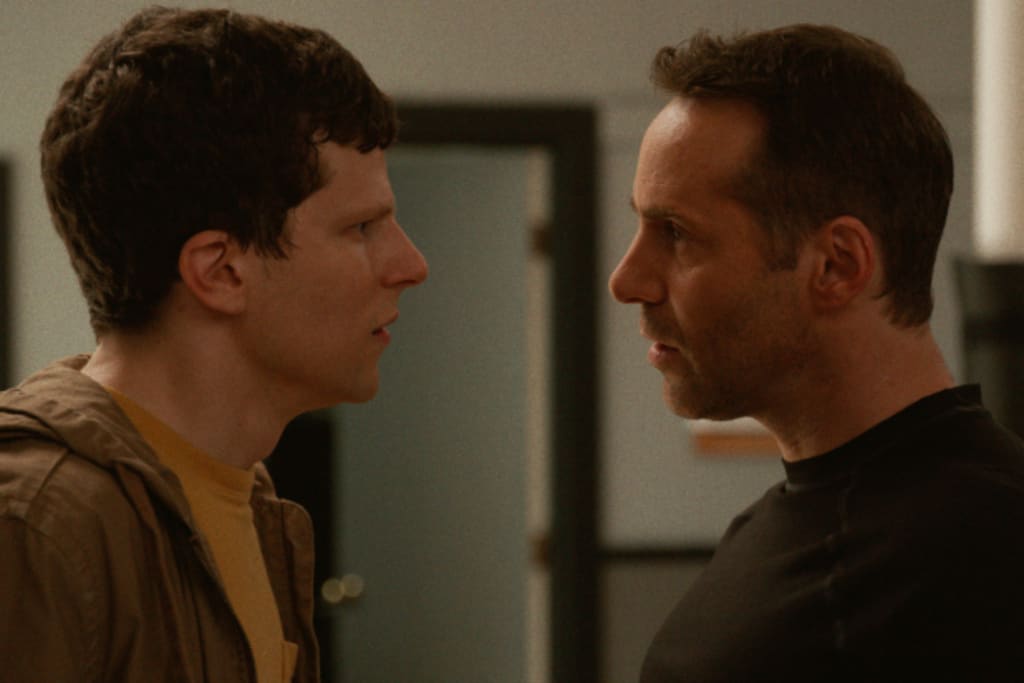Movie Review: 'The Art of Self Defense' Is a Strange Failure of Tone
I want to like 'The Art of Self Defense' but the movie won't let me.

The Art of Self Defense defied my attempts to like it. I wanted to enjoy the odd tone and the strange sense of humor of writer-director Riley Stearns. I wanted to enjoy the hipster send up of masculinity that is at the core of The Art of Self Defense, but the film's highly self-conscious style kept putting me at a distance before finally, with nothing to grasp onto aside from an appreciation of the style of the film, I finally left defeated and deflated.
The Art of Self Defense stars Jesse Eisenberg as Casey. Casey is, for lack of a better descriptor, a wimp. Casey is put upon at work, and lonely at home. He appears to have no friends or family, because any type of relationship inspires fear. He states a friendship with his boss, but that relationship is transactional. The friendship with Casey's boss is based on what Casey does for the company, and not on any abiding shared feeling of kinship.
Casey's only steady relationship is with his dog, a cute Dachshund. It is the cute pup who, incidentally, kicks off the plot of The Art of Self Defense. Casey has run out of dog food, and to satisfy his adorable pooch, he must make a late night trek to a nearby grocery store. As he is returning home, Casey finds himself surrounded by menacing figures on motorcycles. These helmeted bullies assault Casey, and leave him comatose on the street.
When Casey awakens, he's more skittish than before, but he's also filled with a greater sense of impotent rage. This rage first leads Casey to consider buying a gun. Eventually, however, Casey stumbles onto a local karate dojo run by a man who refers to himself only as Sensei (Alessandro Nivola). Casey is taken by the forcefulness and discipline of karate, and by Sensei's odd charisma.
Casey is also taken with Anna (Imogen Poots), the instructor for the children's classes at the dojo. Casey's manner doesn't allow for him to flirt or even speak directly with a woman, but it's clear what catches his eye. Sensei wins Casey over to purchasing a dojo membership after inviting him to class and filling that class with a load of masculine nonsense that appeals to the less than typically masculine Casey.
Casey desires to no longer fear other men. He wants to feel powerful, and live up to societal constructs of masculinity. Karate empowers Casey to feel strength that he's never felt before, but it also appeals to his sense of order and justice. The belt system of colors that delineate each level of karate mastery gives Casey the sense of order he also got from his job as an accountant, but with a muscular edge.
I won't spoil what happens next. The story of The Art of Self Defense has a modest twist, and the dojo has a secret side that will be revealed when Casey earns an invitation to the 'night classes' at the dojo. There is a bit of a rush to get to the twist of The Art of Self Defense and that rush is among the reasons the movie put me off. Instead of a slow burn, or even a big, shocking reveal, the 'twist' is given away with little fanfare.
This does open some new avenues in the story to explore with these highly unique characters, but that doesn't keep this choice from being jarring and off-putting. Once the truth of the story is out there, the real problems of The Art of Self Defense emerge. Those problems are rooted in the esoteric and idiosyncratic performances and highly affected direction of writer-director Riley Stearns.
With the twist revealed, The Art of Self Defense begins to fall back on ticks and quirks. Jesse Eisenberg especially moves from a character reacting to an ever-more elevated circumstance to a collection of tics and practiced affectations. The same goes for Alessandro Nivola, who is the funniest part of The Art of Self Defense until the plot is fully revealed, and then the jokes stop being funny.
It's as if Riley Stearns wrote himself into a corner, and could not find a satisfying way out. Instead of taking the film to ever-increasingly strange and interesting places, Stearns remains more interested in schtick. Each of the main actors of The Art of Self Defense is playing on a very specific character beat, and though you might think that the story will call on them to build upon those tics to deepen the story, or heighten the humor, or drama, or suspense, the tone never changes.
Even a final act of explosive violence and supposed shock misfires because none of the characters gives any sense of the stakes of such a shock. Every scene is played at the same deadpan, edgy, satirical tone that keeps the audience from engaging in what is happening. I wanted to like The Art of Self Defense. I was really intrigued by this odd world filled with odd characters, but in the end, the movie spends so much time spinning its esoteric wheels that it never goes anywhere.
About the Creator
Sean Patrick
Hello, my name is Sean Patrick He/Him, and I am a film critic and podcast host for the I Hate Critics Movie Review Podcast I am a voting member of the Critics Choice Association, the group behind the annual Critics Choice Awards.






Comments
There are no comments for this story
Be the first to respond and start the conversation.